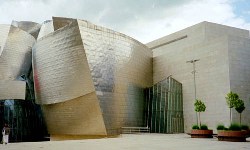When Frank Gehry's Guggenheim Museum Bilbao opened in October, 1997, the architect's architect, Philip Johnson, called it "the greatest building of our time." This week, nearly 13 years later, Gehry and his Guggenheim are back amassing superlatives, courtesy of Vanity Fair. Previewing its August issue, the magazine's website just reported that its poll of 52 architectural experts, including 11 Pritzker Prize winners, found Bilbao the most important piece of architecture built since 1980.
After more than 20 years of interviewing Gehry for newspapers, magazines and books, I could only imagine his satisfaction at this latest accolade. Long accepted more by artists than by his architectural colleagues, a younger Gehry even titled a lecture, "I'm Not Weird." Gehry's wildly original house, the one some of his Santa Monica, California neighbors originally called an eyesore, has had so much tourist traffic over the years that the architect once quipped to me that he wished he'd sold popcorn there.
When I asked him a few years ago about the impact of the Bilbao commission on his career, the 81-year-old architect told me quite simply, "I guess it did put the city of Bilbao on the map, and I guess it put me on the map. After Bilbao, better projects were coming in. I'm sure it's true that it was a turning point, but I don't relate to it like that. From my perspective it's all hard.
"Even when a building is finished, it feels precarious to me. Since it doesn't really look like something else I've seen, I worry that it's some kind of bizarre thing. I feel self-conscious about it, and I want to hide. I want to crawl under the blankets. When I saw Bilbao for the first time, I said, "oh, my God, what have I done to these people?'

Something good, actually. Determined to make culture a major part of transforming the industrial city of Bilbao, the Guggenheim's Spanish partners were after not just a world-class museum but a beacon, a catalyst for change and much more. "Frank Gehry had to turn our industrial site into an urban space, accessible and welcome to visitors," Guggenheim Bilbao's longtime director Juan Ignacio Vidarte told me when I visited there. "We told him we wanted a museum that would show a 100-ton sculpture and a watercolor at the same time and each at its best."
That's not all. They also wanted him to provide the city with what Vidarte calls "a visual identity," creating something that would do unto Bilbao what the Sydney Opera House did unto Sydney. In my book, Conversations with Frank Gehry, published last year by Knopf, I quote Gehry saying they actually told him just that--they wanted a Sydney Opera House. And what was his reply? "I said, "Well, that's a big order. I can't guarantee anything like that. But I'll do my best."
Gehry's "best" has since hosted more than 10 million museum visitors, many of them visiting Bilbao for the first time, as well as nearly 90 exhibitions. Within a few years, the 100-year-old Museum of Fine Arts in Bilbao had to expand to handle all its new visitors, and construction was booming all over town. Basque government officials have reported millions of Euros in Bilbao tourism generated by the new museum, including more than 300 million Euros last year alone.

I reached Gehry in Paris, where he is working on a project, and asked him his reaction to this newest nod from his peers. "What I'm proudest of is that it works as an art museum," Gehry told me earlier today. "The artists I respect love it, and it turned out to be a good investment for the client. It was built on budget--actually, slightly under budget--and it's paid off like mad.
"I always feel it could have been better, and I see things I would have done differently. But I was happy about this. It was unexpected--and I didn't vote for myself."